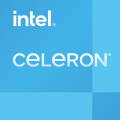The NetBurst microarchitecture, called P68 inside Intel, was the successor to the P6 microarchitecture in the x86 family of central processing units (CPUs)...
16 KB (1,648 words) - 01:48, 3 January 2025
Micro-FCBGA processor package Heart of the Intel mobile Centrino system 400 MHz NetBurst-style system bus Family 6 model 9 Variants 900 MHz (ultra-low voltage)...
199 KB (13,736 words) - 22:13, 25 May 2025
November 20, 2000 until August 8, 2008. All Pentium 4 CPUs are based on the NetBurst microarchitecture, the successor to the P6. The Pentium 4 Willamette (180 nm)...
45 KB (5,367 words) - 18:30, 26 May 2025
Pentium (section NetBurst microarchitecture based)
management features. In 2000, Intel introduced a new microarchitecture named NetBurst, with a much longer pipeline enabling higher clock frequencies than the...
41 KB (2,656 words) - 09:55, 8 March 2025
microarchitecture series which started in 1995 with Pentium Pro. It also replaced the NetBurst microarchitecture, which suffered from high power consumption and heat...
57 KB (3,500 words) - 01:59, 17 May 2025
2011-04-22. "Replay: Unknown Features of the NetBurst Core. Page 15". Replay: Unknown Features of the NetBurst Core. xbitlabs.com. Archived from the original...
21 KB (2,450 words) - 00:49, 19 April 2025
This is a list of NetBurst-based Intel Xeon processors. Based on NetBurst microarchitecture All models support: MMX, SSE, SSE2 All models support dual-processor...
36 KB (780 words) - 02:13, 1 August 2024
i786 may refer to: NetBurst, post 6th-generation Intel microarchitecture (P68) Athlon, 7th-generation AMD microarchitecture The SSE2 instruction set, as...
276 bytes (67 words) - 18:48, 28 March 2023
Xeon (section NetBurst-based Xeon)
("Pentium" was dropped from the name). The initial variant that used the new NetBurst microarchitecture, "Foster", was slightly different from the desktop Pentium...
115 KB (7,773 words) - 05:30, 17 March 2025
Pentium M platform on desktop motherboards. Because the Pentium 4 and other NetBurst CPUs proved less energy efficient than the Pentium M, in late 2004 and...
5 KB (399 words) - 14:32, 5 January 2025
Intel targeted at the consumer and enterprise markets. It is based on the NetBurst microarchitecture. Intel Family 15 Model 1 All models support: MMX, SSE...
52 KB (1,159 words) - 18:29, 25 May 2025
PCI Express interfaces. As Intel didn't have a 4P-capable chipset for NetBurst-based Xeons until 2005, for three years ServerWorks GC-HE served as the...
31 KB (1,437 words) - 08:46, 27 May 2025
Empire Strikes Back". www.anandtech.com. Retrieved 2023-06-24. "Intel's Netburst: Failure is a Foundation for Success". Chips and Cheese. 2022-06-17. Retrieved...
9 KB (1,101 words) - 01:11, 10 December 2024
Celeron (section NetBurst-based Celerons)
from AMD's Duron budget processor. Intel later responded by releasing the NetBurst Willamette Celeron, and for some time Tualatin Celerons were manufactured...
56 KB (6,085 words) - 20:51, 28 March 2025
earlier chipsets (Intel 915 and below) tend to support only single core NetBurst Pentium 4 and Celeron CPUs at an FSB of 533/800 MT/s. Intermediate chipsets...
11 KB (1,110 words) - 12:11, 20 March 2025
Pentium D is a range of desktop 64-bit x86-64 processors based on the NetBurst microarchitecture, which is the dual-core variant of the Pentium 4 manufactured...
20 KB (2,359 words) - 09:59, 17 March 2025
among all cores. Nehalem is an architecture that differs radically from NetBurst, while retaining some of the latter's minor features. Nehalem later received...
32 KB (1,476 words) - 02:32, 4 June 2025
frequently referred to as i686. It was planned to be succeeded by the NetBurst microarchitecture used by the Pentium 4 in 2000, but was revived for the...
15 KB (1,545 words) - 12:10, 6 February 2025
List of Intel Xeon processors (section NetBurst-based)
The following is a list of Intel Xeon microprocessors, by generation. Pentium II Xeon 400 Pentium II Xeon 400 Pentium II Xeon 450 Pentium II Xeon 450 Pentium...
95 KB (3,773 words) - 17:20, 30 May 2025
first x86 to have shadow register architecture and speed step technology. NetBurst commonly referred to as P7 although its internal name was P68 (P7 was used...
52 KB (2,899 words) - 00:13, 4 May 2025
rice.edu. Retrieved February 26, 2021. "IMS T800 Architecture". transputer.net. Retrieved December 28, 2023. Epiphany-III 16-core 65nm Microprocessor (E16G301)...
59 KB (3,379 words) - 16:14, 14 May 2025
as well as variations of these names. Desktop processors based on the NetBurst microarchitecture were marketed as Pentium 4 and Pentium D. Earlier E5xxx...
101 KB (3,933 words) - 19:46, 3 February 2025
(PDF). Replay: Unknown Features of the NetBurst Core (2005-06-06). "Replay: Unknown Features of the NetBurst Core". X-bit labs. Archived from the original...
4 KB (451 words) - 14:15, 2 December 2024
followed this approach with the Execution Trace Cache feature in their NetBurst microarchitecture (for Pentium 4 processors) and later in the Decoded Stream...
105 KB (10,776 words) - 12:49, 18 April 2025
April 2011. "Replay: Unknown Features of the NetBurst Core. Page 15". Replay: Unknown Features of the NetBurst Core. Xbitlabs. Archived from the original...
29 KB (2,986 words) - 10:44, 14 March 2025
Pentium 4 and Pentium D. In the succeeding years after the demise of the NetBurst microarchitecture and its 3+ GHz CPUs, microprocessor clock speeds kept...
9 KB (1,240 words) - 03:17, 7 February 2025
continued to develop the classic x86 architecture as Intel deviated with its NetBurst architecture for the Pentium 4 CPUs and the IA-64 architecture for the...
73 KB (8,112 words) - 14:52, 23 May 2025
Celeron 7305L: Specifications and Benchmark Ratings - SiliconCat". SiliconCat.net. Retrieved 2024-10-01. ^ New Celeron 220, Xtreview 15 October 2007 Search...
152 KB (4,647 words) - 00:58, 15 April 2025
out-of-order microprocessors but were supplanted by the NetBurst architecture. Years later, NetBurst proved to be a dead end due to its long pipeline that...
36 KB (4,220 words) - 15:27, 28 April 2025












